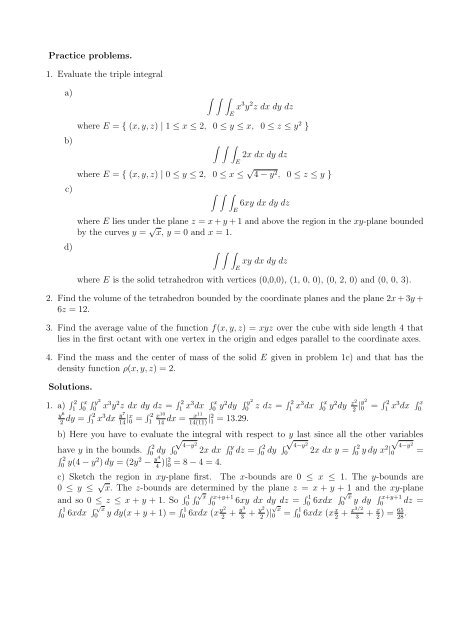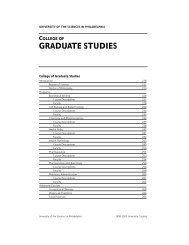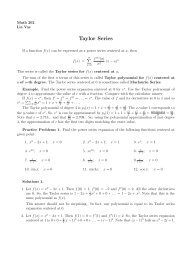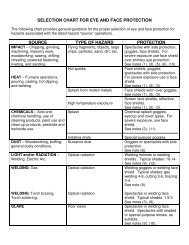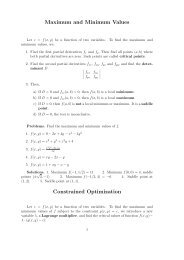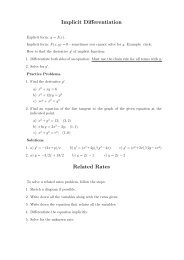Triple Integrals
Triple Integrals
Triple Integrals
Create successful ePaper yourself
Turn your PDF publications into a flip-book with our unique Google optimized e-Paper software.
Practice problems.<br />
1. Evaluate the triple integral<br />
a) ∫ ∫ ∫<br />
E<br />
x 3 y 2 z dx dy dz<br />
where E = { (x, y, z) | 1 ≤ x ≤ 2, 0 ≤ y ≤ x, 0 ≤ z ≤ y 2 }<br />
b) ∫ ∫ ∫<br />
E<br />
2x dx dy dz<br />
where E = { (x, y, z) | 0 ≤ y ≤ 2, 0 ≤ x ≤ √ 4 − y 2 , 0 ≤ z ≤ y }<br />
c) ∫ ∫ ∫<br />
E<br />
6xy dx dy dz<br />
where E lies under the plane z = x + y + 1 and above the region in the xy-plane bounded<br />
by the curves y = √ x, y = 0 and x = 1.<br />
d) ∫ ∫ ∫<br />
E<br />
xy dx dy dz<br />
where E is the solid tetrahedron with vertices (0,0,0), (1, 0, 0), (0, 2, 0) and (0, 0, 3).<br />
2. Find the volume of the tetrahedron bounded by the coordinate planes and the plane 2x + 3y +<br />
6z = 12.<br />
3. Find the average value of the function f(x, y, z) = xyz over the cube with side length 4 that<br />
lies in the first octant with one vertex in the origin and edges parallel to the coordinate axes.<br />
4. Find the mass and the center of mass of the solid E given in problem 1c) and that has the<br />
density function ρ(x, y, z) = 2.<br />
Solutions.<br />
1. a) ∫ 2<br />
∫ x<br />
1 0<br />
∫ y 2<br />
0 x 3 y 2 z dx dy dz = ∫ 2<br />
1 x3 dx ∫ x<br />
0 y2 dy ∫ y 2<br />
0 z dz = ∫ 2<br />
1 x3 dx ∫ x<br />
0 y2 dy z2<br />
2 |y2 0 = ∫ 2<br />
1 x3 dx ∫ x<br />
0<br />
y 6<br />
2 dy = ∫ 2<br />
1 x3 dx y7<br />
14 |x 0 = ∫ 2<br />
1 x10<br />
14<br />
dx =<br />
x11<br />
14(11) |2 1 = 13.29.<br />
b) Here you have to evaluate the integral with respect to y last since all the other variables<br />
have y in the bounds. ∫ 2<br />
0 dy ∫ √ 4−y 2<br />
0 2x dx ∫ y<br />
0 dz = ∫ 2<br />
0 dy ∫ √ 4−y 2<br />
0 2x dx y = ∫ √<br />
2<br />
0 y dy x2 4−y<br />
|<br />
2<br />
0 =<br />
∫ 2<br />
0 y(4 − y2 ) dy = (2y 2 − y4<br />
4 )|2 0 = 8 − 4 = 4.<br />
c) Sketch the region in xy-plane first. The x-bounds are 0 ≤ x ≤ 1. The y-bounds are<br />
0 ≤ y ≤ √ x. The z-bounds are determined by the plane z = x + y + 1 and the xy-plane<br />
and so 0 ≤ z ≤ x + y + 1. So ∫ 1 ∫ √ x ∫ x+y+1<br />
0 0 0 6xy dx dy dz = ∫ 1<br />
0 6xdx ∫ √ x<br />
0 y dy ∫ x+y+1<br />
0 dz =<br />
∫ 1<br />
0 6xdx ∫ √ x<br />
0 y dy(x + y + 1) = ∫ 1<br />
y2<br />
0 6xdx (x + y3<br />
+ y2<br />
2 3 2 )|√ x<br />
0 = ∫ 1<br />
0 6xdx (x x + x3/2 + x) = 65.<br />
2 3 2 28


